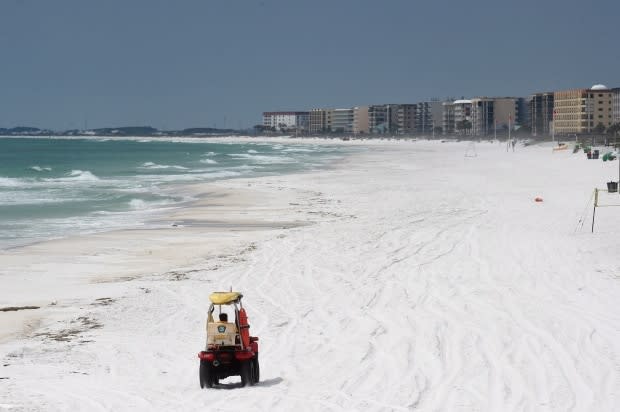Canada's next-door neighbour is now the epicentre of global pandemic. Here's what that U.S. surge means

Canada's next-door neighbour is now the epicentre of a global pandemic. The tremors coming from America will ripple across the border and beyond.
The United States has by far the most reported cases of COVID-19 of any country, not just in total numbers but also with a per-capita rate that apparently dwarfs Canada's.
A staggering array of effects will be felt in both countries: a battered economy, suspended cross-border work trips, holidays cancelled, families separated, loved ones suffering.
One such effect was highlighted Monday by U.S. President Donald Trump. He voiced his intention to extend international travel restrictions currently set to expire April 12 for visitors entering from Europe and to April 20 for those entering the U.S. from Canada.
That's after he extended social-distancing guidelines until April 30, citing grim projections that inaction could cost up to 2.2 million Americans their lives.
When asked Monday about the travel restrictions on Canada and Europe, Trump acknowledged they would likely also remain in place at least until April 30: "The guidelines will be very much as they are."
Epidemiologists urge caution in interpreting the U.S. numbers.
They say international comparisons are susceptible to error, because medical strategies and data-collection differ, complicating apples-to-apples comparisons.
But here's what the U.S. numbers say; what they don't say; and what the U.S. spike in cases might mean for Canadians.

What we know
The United States had approximately 20 times the reported cases of Canada and more than 25 times the number of deaths as of Monday evening.
The U.S. population (330 million) is about nine times higher than Canada's (37 million).
America's 161,000 reported cases was by far the highest number in the world, followed by about 102,000 in Italy and under 90,000 currently reported by each China and Spain. Canada has just over 7,400 officially reported cases.
One epidemiologist and public-health specialist who checked the totals Monday estimated that the rate of infections was, in fact, about 2.9 times higher in the U.S. than in Canada.
James Blanchard of the University of Manitoba pegged the U.S. rate at 43 infected per 100,000, compared with 15 per 100,000 in Canada.
"Seeing almost a three-fold higher number of cases in the U.S. than in Canada suggests the current burden is higher than in Canada," said Blanchard, who was trained at Johns Hopkins University in Baltimore, Md., and who researches how individuals and communities spread illness.
"It seems unlikely that Canada's pace is going to catch up to the U.S."
Saverio Stranges, the chair of epidemiology and biostatistics at Western University's Schulich School in London, Ont., concurred "it is extremely likely" that the case rate is higher in the U.S.
Trump has tried presenting the higher American rate as a success story involving American testing.
"We test more than anybody else," Trump told Fox News on Monday. "So, we will show [more]."
Blanchard said there's no evidence the U.S. has tested more people — at least not per capita. Canada said Monday it had tested more than 221,000 people, or about six tests for every 1,000 Canadians, while Trump said Monday that the U.S. had tested over one million people, which amounts to about three tests per 1,000 Americans.

What we don't know
Blanchard and Stranges warn that country-to-country comparisons can be a minefield. "It's extremely difficult to make these comparisons," Stranges said.
For starters, both cautioned against seeing pandemics as national events. In reality, they said, they're a series of local phenomena. Stranges said nearly half the U.S. cases are in New York state — just as, in his native Italy, the worst-hit region was Lombardy, around Milan, while elsewhere in Italy, the numbers were closer to the international norm.
Blanchard said New York City might be uniquely prone because of its population density; also, more than 65 million visitors flocked there last year.
"Within each country there are many focal epidemics," Blanchard said. "The future trajectory for each country will be determined by how well the epidemics in larger population centres are controlled."
WATCH | U.S. projects over 100,000 COVID-19 deaths:
Another huge issue is testing methodology. Even within the same country, differences in data-collection complicate the ability to make comparisons.
Take Canada's two most-populous provinces. The largest, Ontario, has reported just over 1,700 cases — but has experienced large testing backlogs. As of Monday evening, Ontario had tested 48,461 people, and 5,651 test results were pending.
Quebec, meanwhile, has more reported cases than Ontario but has also tested far more people than its neighbour.
The same difficulties arise where comparing different countries.
"I am cautious about interpreting the [Canada-U.S.] data," Blanchard said.
However, he said, the U.S. rate of infection is likely still higher than Canada's. If anything, he said, Canada has done a better job testing people and the actual gap with the U.S. could be even wider.

What it means for Canadians
In short, deep disruption and confusion for a broad range of Canadians, from businesses, to professional travellers, to tourists, to people separated from loved ones.
And that's not to mention the chain-reaction of effects when the world's biggest economic powerhouse stalls.
A stunning new estimate from the U.S. Federal Reserve says the American unemployment rate could hit an eye-popping 32 per cent in this quarter.
That evaporation of American incomes would further batter Canada's economy, given that three-quarters of Canada's international exports go to the U.S.
Then there are Canadians with property in the U.S. It's unclear when they'll get to return.
Michael MacKenzie, executive director at the Canadian Snowbird Association, said he suspects virtually all 115,000 of his group's members have left the U.S. He said people rushed home over a week ago on government instructions, which coincided with health-insurance providers suspending policies.
"I'm not personally aware of any of our members still there," he said.
People with professional visas are mostly not travelling either, even if they're allowed.
Andrea Vaitzner, an immigration lawyer at Norton Rose Fulbright in Montreal said professional travellers are being deterred by the lockdown orders in various U.S. cities and by the Canadian order to self-quarantine for 14 days after foreign travel.
The latest stay-at-home orders Monday came from Washington, D.C., and neighbouring Maryland and Virginia.
"I am telling clients to stay put for now," Vaitzner said.
She said border towns that rely on Canada-U.S. travel are being hit especially hard.
One border town is starting to suffer a heavy humanitarian toll: Detroit, where cases are surging. And Canadian medical workers are getting a gut-wrenchingly close-up view.
"My district relies on 1,000 Canadian nurses," Rashida Tlaib, a member of the U.S. Congress from Detroit, told a U.S. House hearing this month, urging that essential workers be allowed to keep flowing across the border.
They still are.
Jenna Meloche is one of those essential workers in a Detroit hospital.
The nurse from Windsor, Ont., has described how the highly contagious nature of COVID-19 forces patients to die in isolation. Loved ones ask medical staff like her to deliver final goodbye messages.
Meloche said hospital staff pray before their shifts. She lives with her parents and now wears a mask at home, uses a separate bathroom and is looking at getting a separate place.
"I think you have to give yourself a little mirror pep talk in the morning before you go into work," she told CBC News.
"The way I view it is I have the luxury of helping these people get through the most difficult time in their life. … And I think that is the main reason why my mom, my sister, my great aunt and a lot of my friends got into nursing — is to have the opportunity to help these people ...
"So, I feel grateful."


